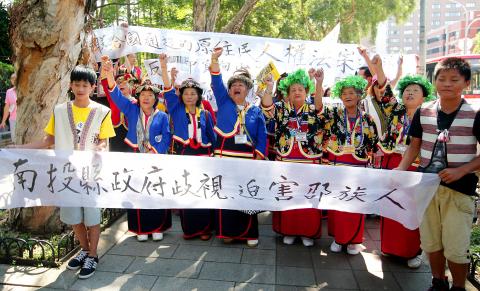Performing a traditional exorcism ritual, a group of Thao Aborigines yesterday protested against a build-operate-transfer (BOT) resort project near Sun Moon Lake on Thao traditional lands, for which the government gave initial approval without consulting them.
Sprinkling self-brewed alcohol into the sky with her fingers while reciting spells, an elderly Thao shaman performed the traditional ritual to drive away evil spirits in front of the Executive Yuan.
“The evil is in there,” she said, pointing at the Executive Yuan compound.

Photo: CNA
Following the shaman were dozens of Thao Aborigines in their traditional dress, holding banners accusing the government of exploiting the Thao and urging the government to return their traditional domains to them.
“Sun Moon Lake and the surrounding areas are traditional territories of the Thao, but now the government is introducing Chinese capital to build a resort without having consulted us as the Aboriginal Basic Act [原住民族基本法] requires,” Thao National Assembly Speaker Banu Bagamumu told reporters.
While the government promised that the resort would bring jobs to locals, Banu Bagamumu said that Chinese tour agencies always bring along their own business partners and “the project will not benefit us at all.”
He called on the Executive Yuan to nullify its initial approval for the project and suspend all BOT plans before a program to revive traditional Thao culture is in place.
Indigenous Peoples’ Action Coalition secretary-general Omi Wilang, an Atayal, said that currently, there are only a few thousand Thao left in the country, who are struggling to keep their tribe and their culture alive.
“What the government should do for an ethnic group that is in such a disadvantaged position is protect, not to accelerate its peril,” Omi Wilang said.
Democratic Progressive Party Legislator Tien Chiu-chin (田秋堇) said that besides assessing the impact of the development project on the environment, the government “should equally assess its impact on the Thao culture.”
The Sun Moon Lake National Scenic Area Administration Office and the Nantou County Government are planning to work with a developer to build a four-star resort hotel costing more than NT$2 billion (US$66 million) near the lake.
The project is financed by Hong Kong’s Bonds Group. If it goes ahead as planned, the resort will be completed and opened in 2017.
Thao Aborigines and their supporters are expected to protest in front of the Environmental Protection Administration in Taipei on Friday.

The Central Weather Administration (CWA) yesterday said it expected to issue a sea warning for Typhoon Fung-Wong tomorrow, which it said would possibly make landfall near central Taiwan. As of 2am yesterday, Fung-Wong was about 1,760km southeast of Oluanpi (鵝鑾鼻), Taiwan’s southernmost point, moving west-northwest at 26kph. It is forecast to reach Luzon in the northern Philippines by tomorrow, the CWA said. After entering the South China Sea, Typhoon Fung-Wong is likely to turn northward toward Taiwan, CWA forecaster Chang Chun-yao (張峻堯) said, adding that it would likely make landfall near central Taiwan. The CWA expects to issue a land

Taiwan’s exports soared to an all-time high of US$61.8 billion last month, surging 49.7 percent from a year earlier, as the global frenzy for artificial intelligence (AI) applications and new consumer electronics powered shipments of high-tech goods, the Ministry of Finance said yesterday. It was the first time exports had exceeded the US$60 billion mark, fueled by the global boom in AI development that has significantly boosted Taiwanese companies across the international supply chain, Department of Statistics Director-General Beatrice Tsai (蔡美娜) told a media briefing. “There is a consensus among major AI players that the upcycle is still in its early stage,”

The Central Weather Administration (CWA) yesterday said it is expected to issue a sea warning for Typhoon Fung-wong this afternoon and a land warning tomorrow. As of 1pm, the storm was about 1,070km southeast of Oluanpi (鵝鑾鼻), Taiwan’s southernmost point, and was moving west-northwest at 28 to 32kph, according to CWA data. The storm had a radius of 250km, with maximum sustained winds of 173kph and gusts reaching 209kph, the CWA added. The storm is forecast to pass near Luzon in the Philippines before entering the South China Sea and potentially turning northward toward Taiwan, the CWA said. CWA forecaster Chang Chun-yao (張峻堯) said

Japanese Prime Minister Sanae Takaichi yesterday said that China using armed force against Taiwan could constitute a "survival-threatening situation" for Japan, allowing the country to mobilize the Japanese armed forces under its security laws. Takaichi made the remarks during a parliamentary session while responding to a question about whether a "Taiwan contingency" involving a Chinese naval blockade would qualify as a "survival-threatening situation" for Japan, according to a report by Japan’s Asahi Shimbun. "If warships are used and other armed actions are involved, I believe this could constitute a survival-threatening situation," Takaichi was quoted as saying in the report. Under Japan’s security legislation,